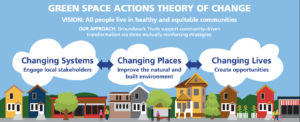Among older industrial “legacy cities” there is a growing movement to adapt and implement green and sustainable policies and programming as a catalyst for urban regeneration. Much of their early work around sustainability policies, plans, projects, and programs (the 4Ps) involved creative ways of greening vacant land caused by deindustrialization and decades of population loss (See VPRN Urban Greening Policy Brief). Part of the challenge for policymakers, practitioners and researchers is to collaboratively document and assess how, when, and where sustainability and urban greening can be most effective and equitable.
Starting with Schilling and Logan’s seminal article “Greening the Rust Belt,” VPR Network has been at the forefront of documenting the urban greening strategies and initiatives of public, private and nonprofit entities that provide communities with immediate and wide-ranging health, economic, social and civic benefits.
In 2013, through the Center for Community Progress, Schilling co-authored a yearlong policy study—that examines a national network of community-based organizations (e.g. Groundwork (GW) USA) that engage residents and youth in urban greening and restoring distressed waterways. More recently VPR Network served as advisors to GW USA’s 2019 community health assessment of their network’s programs and projects for transforming neighborhood-scale brownfields into high quality green spaces. This analysis documents how the Groundwork Model empower communities to practice cross-sector leadership while investing in local stakeholders to strengthen a sense of ownership, promote community healing, and build wealth and wellness .
With a surplus of vacant land and abandoned buildings, dozens of legacy cities continue to transform hundreds of vacant lots into emerging networks of community gardens, urban farms and forests, pocket parks, and green infrastructure projects for absorbing stormwater and vehicle emissions. In May 2015, the VPR Network released its first research translation brief—Greening Legacy Cities—that synthesizes research on the multiple socio, economic and environmental benefits derived such urban greening initiatives. Building on this body of work, VPR Network has also convened a special working group on urban greening in legacy cities as a vehicle for cross-city and cross-sector collaboration. .
Now with support from the Lincoln Institute of Land Policy, a VRP Network team from the Urban Institute is conducting a three year project to learn more about the urban sustainability endeavors of small and midsized legacy cities. In 2019 the team completed a scan of sustainability policies, plans, programs and projects—the Greenventory. For 2020 the team will be convening two regional focus groups and reaching out to local government officials and community based organizations in legacy cities to understand the barriers for smaller municipalities and how to overcome them. If you know of good examples and/or want to nominate programs and policies from your city, town or township, please click here or email us contact@vacantpropertyresearch.com

